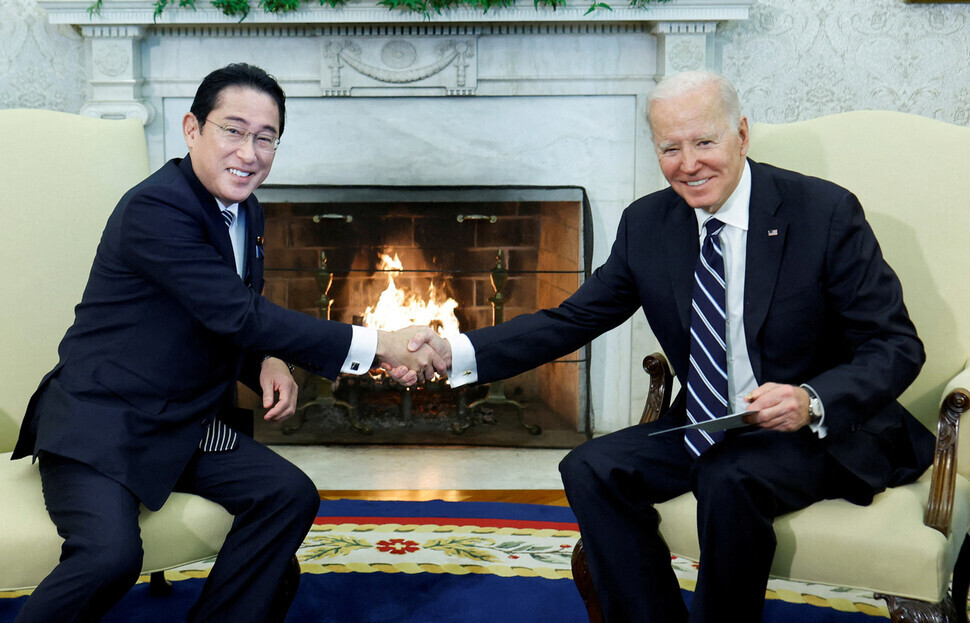hankyoreh
Links to other country sites 다른 나라 사이트 링크
[Editorial] US endorsement of Japan’s militarization could fuel NE Asia arms race

The US has officially approved Japan’s plan to acquire counterstrike capabilities and double its defense spending over the next five years.
With this, Japan is effectively abandoning its principle of exclusively using defensive capabilities when under attack, which it has adhered to for over seven decades. It is also gaining strong reinforcements for its march to become a military power.
The overt boosting of the US-Japan alliance’s military cooperation in the face of the challenges posed by China threatens to accelerate the arms race in Northeast Asia.
In successive “2+2” foreign affairs and defense minister talks and a summit meeting with Japan in Washington on Friday and Saturday, the US expressed strong support for Japan’s acquisition of counterstrike capabilities and large increase in military spending.
“We’re modernizing our military alliance, building on Japan’s historic increase in defense spending and new National Security Strategy,” US President Joe Biden said.
In their joint statement, the US and Japanese leaders said they had “instructed their ministers to reinforce cooperation on the development and effective employment of Japan’s counterstrike and other [military] capabilities.”
The two sides also agreed to broaden the scope of their activities with Japan’s purchase of hundreds of US-made Tomahawk missiles, expansion of US Marine units on Okinawa to regiment scale, and enhancements to maneuverability.
These activities by the US and Japan mean a fundamental shift in the division of roles that has existed since World War II, where the US has been the “sword” and Japan the “shield” in terms of offensive and defensive capabilities. While the aim is to respond to the new environment represented by China’s military challenge, it seems likely that the countries of Northeast Asia will end up drawn into the vicious cycle of an arms race.
Arms races raise tensions and increase the likelihood of an unintended clash. This sort of situation isn’t helpful to any country.
Due to its geopolitical position, the Korean Peninsula stands to suffer the most from a race of military capabilities among major powers. At times like this, South Korea’s role takes on even greater importance.
We may not be able to act as mediators among those powers, but we at least need to play a leading role in establishing safeguards to prevent unintended clashes from erupting in Northeast Asia.
During the Cold War, the countries of Europe were able to lessen hostilities and achieve coexistence by establishing the Organization for Security and Co-operation in Europe. Along the same lines, one answer may lie in creating a Northeast Asian security and cooperation organization.
In that sense, it’s deeply concerning to see President Yoon Suk-yeol’s recent references to the possibility of South Korea arming itself with nuclear capabilities, as well as his remarks that seem to express acceptance of Japan’s moves to become a military power.
Rather than simply throwing support behind this strengthening of US and Japanese military capabilities, we hope Seoul will work quickly to marshal its diplomatic resources toward managing tensions.
Please direct questions or comments to [english@hani.co.kr]

Editorial・opinion
![[Column] Park Geun-hye déjà vu in Yoon Suk-yeol [Column] Park Geun-hye déjà vu in Yoon Suk-yeol](https://flexible.img.hani.co.kr/flexible/normal/500/300/imgdb/original/2024/0424/651713945113788.jpg) [Column] Park Geun-hye déjà vu in Yoon Suk-yeol
[Column] Park Geun-hye déjà vu in Yoon Suk-yeol![[Editorial] New weight of N. Korea’s nuclear threats makes dialogue all the more urgent [Editorial] New weight of N. Korea’s nuclear threats makes dialogue all the more urgent](https://flexible.img.hani.co.kr/flexible/normal/500/300/imgdb/original/2024/0424/7317139454662664.jpg) [Editorial] New weight of N. Korea’s nuclear threats makes dialogue all the more urgent
[Editorial] New weight of N. Korea’s nuclear threats makes dialogue all the more urgent- [Guest essay] The real reason Korea’s new right wants to dub Rhee a founding father
- [Column] ‘Choson’: Is it time we start referring to N. Korea in its own terms?
- [Editorial] Japan’s rewriting of history with Korea has gone too far
- [Column] The president’s questionable capacity for dialogue
- [Column] Are chaebol firms just pizza pies for families to divvy up as they please?
- [Column] Has Korea, too, crossed the Rubicon on China?
- [Correspondent’s column] In Japan’s alliance with US, echoes of its past alliances with UK
- [Editorial] Does Yoon think the Korean public is wrong?
Most viewed articles
- 1‘We must say no’: Seoul defense chief on Korean, USFK involvement in hypothetical Taiwan crisis
- 2[Reportage] On US campuses, student risk arrest as they call for divestment from Israel
- 3[Column] Park Geun-hye déjà vu in Yoon Suk-yeol
- 4‘Weddingflation’ breaks the bank for Korean couples-to-be
- 5Korea sees more deaths than births for 52nd consecutive month in February
- 6N. Korean delegation’s trip to Iran shows how Pyongyang is leveraging ties with Moscow
- 7Amnesty notes ‘erosion’ of freedom of expression in Korea in annual human rights report
- 8Will NewJeans end up collateral damage in internal feud at K-pop juggernaut Hybe?
- 9N. Korean hackers breached 10 defense contractors in South for months, police say
- 10[Guest essay] The real reason Korea’s new right wants to dub Rhee a founding father